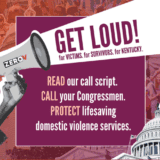It’s About Time (Part 2)
Violence prevention requires community and individual change to be effective, and deep-seated beliefs complicate meaningful shifts. Change does not happen quickly—and time is not on our side.
Domestic violence was seldom a topic of public discourse before 1970. Only 50 years have passed since grassroots rallies, known then as the battered women’s movement, began to raise awareness and call for change. Two decades would pass before the Violence Against Women Act established domestic violence as a federal crime in 1994. This important legislation was signed three months after the infamous police chase of a professional football player attempting to flee domestic homicide charges.
I have witnessed promising community-based solutions since this time. The Kentucky Coalition Against Domestic Violence, a 15-member network of primary services providers, has been leading the change. Local fatality review committees, coordinated in Lexington by the Domestic and Sexual Violence Prevention Coalition, identify gaps that could have prevented the tragedy. Most recently, Mayor Gorton has convened experts from various sectors to determine best-practice strategies.
My role offers the opportunity to discuss these issues with hundreds of people monthly. These conversations remind me that our community wants the violence to end. A survivor recently shared her story with a small group that had gathered to raise awareness and funding for our services. A guest asked which services were helpful to her. The survivor explained that having time to begin healing was the most important.
Research and practice suggest it takes an average of seven attempts, often made over many years, to escape domestic violence permanently. Dozens of factors inform a victim’s decision to reunite with the abuser. Lack of a supportive network, experiences of homelessness after fleeing, and concerns about losing custody of children are common. The most pervasive reason can be more difficult to reckon.
The decision to stay or return is made to keep themselves and their children alive.
Leaving is the most dangerous time, especially if the abuser has access to firearms. Surviving abuse requires a keen sense of threat detection. Victims perceive signs of imminent and more violent abuse, possibly lethal harm, easily missed by others.
When able to establish safety, survivors seldom have time to focus on healing the physical and emotional wounds of abuse. A long uphill battle for stability demands immediate attention. The fallout of financial abuse, part and parcel of domestic violence, can feel insurmountable—lack of affordable housing and living wage employment in our region delay possibilities.
October is a time to demonstrate your support for survivors of domestic violence. Seeking answers to questions can be a good place to start. Does your workplace have a domestic violence policy? How does your place of faith respond to disclosures of intimate partner abuse? Does your professional role require you to provide information and referral if abuse is suspected?
I urge you to participate in domestic violence awareness activities this month. Identify yourself as an advocate and call for an end to the violence. It’s about time.








